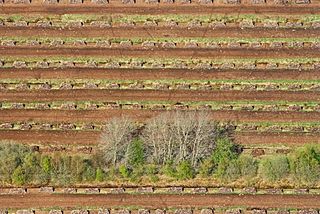The Goidelic or Gaelic languages form one of the two groups of Insular Celtic languages, the other being the Brittonic languages.

Loch is the Irish, Scottish Gaelic and Scots word for a lake or for a sea inlet. It is cognate with the Manx lough, Cornish logh, and one of the Welsh words for lake, llwch.

Scottish Gaelic or Scots Gaelic, sometimes also referred to simply as Gaelic, is a Celtic language native to the Gaels of Scotland. A member of the Goidelic branch of the Celtic languages, Scottish Gaelic, like Modern Irish and Manx, developed out of Middle Irish. Most of modern Scotland was once Gaelic-speaking, as evidenced especially by Gaelic-language placenames.

The Highlands is a historic region of Scotland. Culturally, the Highlands and the Lowlands diverged from the later Middle Ages into the modern period, when Lowland Scots replaced Scottish Gaelic throughout most of the Lowlands. The term is also used for the area north and west of the Highland Boundary Fault, although the exact boundaries are not clearly defined, particularly to the east. The Great Glen divides the Grampian Mountains to the southeast from the Northwest Highlands. The Scottish Gaelic name of A' Ghàidhealtachd literally means "the place of the Gaels" and traditionally, from a Gaelic-speaking point of view, includes both the Western Isles and the Highlands.

Inverness is a city in the Scottish Highlands. It is the administrative centre for The Highland Council and is regarded as the capital of the Highlands. Inverness lies near two important battle sites: the 11th-century battle of Blàr nam Fèinne against Norway which took place on the Aird and the 18th century Battle of Culloden which took place on Culloden Moor. It is the northernmost city in the United Kingdom and lies within the Great Glen at its north-eastern extremity where the River Ness enters the Moray Firth. At the latest, a settlement was established by the 6th century with the first royal charter being granted by Dabíd mac Maíl Choluim in the 12th century. The Gaelic king Mac Bethad Mac Findláich (MacBeth) whose 11th-century killing of King Duncan was immortalised in Shakespeare's largely fictionalized play Macbeth, held a castle within the city where he ruled as Mormaer of Moray and Ross.
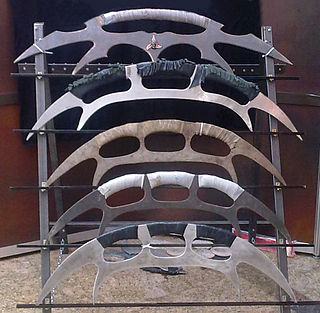
The bat'leth is a double-sided scimitar/hook sword/deer horn knives hybrid-edged weapon with a curved blade, four points, and three handholds on the back. It was designed and created by Star Trek: The Next Generation visual effects producer Dan Curry for the Star Trek franchise, where it is the characteristic melee weapon of Klingons. Curry has called the bat'leth "one of the iconic images associated with the show." It has spawned a smaller version, which became known as the “mek'leth;” in Klingon, this is written meqleH. Bat'leths have become an enduring symbol of the franchise among fans, and they are occasionally referenced in other media.

For local government purposes, Scotland is divided into 32 areas designated as "council areas", which are all governed by single-tier authorities designated as "councils". They have the option under the Local Government (Scotland) Act 1997 of being known as a "comhairle" when opting for a Gaelic name; only Comhairle nan Eilean Siar has chosen this option, whereas the Highland Council has adopted its Gaelic form alongside its English equivalent informally.

Loch Leven is a sea loch located on the west coast of Scotland. It is spelled Loch Lyon in Timothy Pont's map of the area and is pronounced Li' un. The local Gaelic pronunciation is Lee' oon

The Plantation of Ulster was the organised colonisation (plantation) of Ulster – a province of Ireland – by people from Great Britain during the reign of King James VI & I. Most of the colonists came from Scotland, the majority having a different culture to the natives. Small private plantations by wealthy landowners began in 1606, while the official plantation began in 1609. Most of the land colonised was forfeited from the native Gaelic chiefs, several of whom had fled Ireland for mainland Europe in 1607 following the Nine Years' War against English rule. The official plantation comprised an estimated half a million acres (2,000 km²) of arable land in counties Armagh, Cavan, Fermanagh, Tyrone, Tyrconnell and Derry/Londonderry. Land in counties Antrim, Down and Monaghan was privately colonised with the king's support.

A croft is a fenced or enclosed area of land, usually small and arable, and usually, but not always, with a crofter's dwelling thereon. A crofter is one who has tenure and use of the land, typically as a tenant farmer, especially in rural areas.
The davoch, davach or daugh is an ancient Scottish land measurement. All of these terms are cognate with modern Scottish Gaelic dabhach. The word dabh or damh means an "ox", but dabhach can also refer to a "tub", so may indicate productivity. It was called the arachor in the Lennox.
An ounceland is a traditional Scottish land measurement. It was found in the West Highlands, and Hebrides. In Eastern Scotland, other measuring systems were used instead. It was equivalent to 20 pennylands or one eighth of a markland. Like those measurements, it is based on the rent paid, rather than the actual land area. It was also known as a "tirung", or a dabhach, which is a term of Pictish origin, also used in the east of Scotland too, but for a different measurement. The “ounceland” is thought to be of Norse origin, so it is possible that Norse (‘ounceland’) and native systems (dabhach) were conflated in the west.
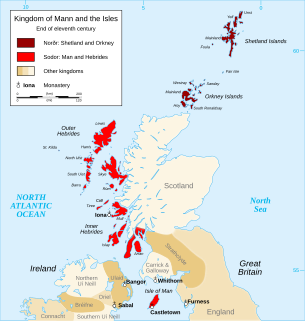
The Norse–Gaels were a people of mixed Gaelic and Norse ancestry and culture. They emerged in the Viking Age, when Vikings who settled in Ireland and in Scotland adopted Gaelic culture and intermarried with Gaels. The Norse–Gaels dominated much of the Irish Sea and Scottish Sea regions from the 9th to 12th centuries. They founded the Kingdom of the Isles, the Kingdom of Dublin, the Lordship of Galloway, and ruled the Kingdom of York for a time. The most powerful Norse–Gaelic dynasty were the Uí Ímair or House of Ivar.
Legavrik was the name for winter in Scotland. Variants include legawreik.
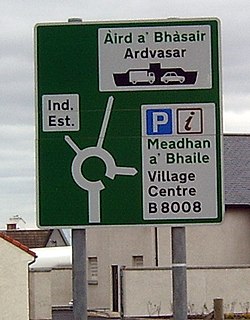
In the Gaelic-speaking parts of Scotland, the use of the Gaelic language on road signs instead of, or more often alongside, English is now common, but has been a controversial issue.

The languages of Scotland are the languages spoken or once spoken in Scotland. Each of the numerous languages spoken in Scotland during its recorded linguistic history falls into either the Germanic or Celtic language families. The classification of the Pictish language was once controversial, but it is now generally considered a Celtic language. Today, the main language spoken in Scotland is English, while Scots and Scottish Gaelic are minority languages. The dialect of English spoken in Scotland is referred to as Scottish English.

The Gaels are an ethnolinguistic group native to northwestern Europe. They are associated with the Gaelic languages: a branch of the Celtic languages comprising Irish, Manx and Scottish Gaelic. Historically, the ethnonyms Irish and Scots referred to the Gaels in general, but the scope of those nationalities is today more complex.
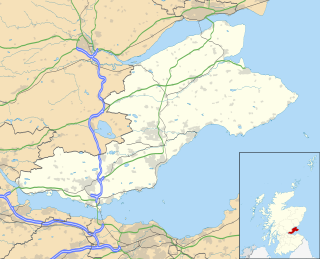
Lathones (/lə'θonz/) is a village in Fife, Scotland, located approximately 6 miles (10 km) south west of St Andrews, in the parish of Cameron.

Roderick John MacLeod, Lord Minginish,, also known as Roddy John, is a Scottish solicitor and advocate. Since 2014 he has been Chairman of the Scottish Land Court and President of the Lands Tribunal for Scotland. He is the first Gaelic-speaking chair of the court.
The Gaels of Scotland or, simply Gaels, are an ethnolinguistic group found in Scotland – including the land of their origins, the Scottish Highlands – and in the diaspora of Scotland within the United States, Canada, Australia and New Zealand. The Gaels as an ethno-linguistic group can also be found in Ireland and the Isle of Mann.


